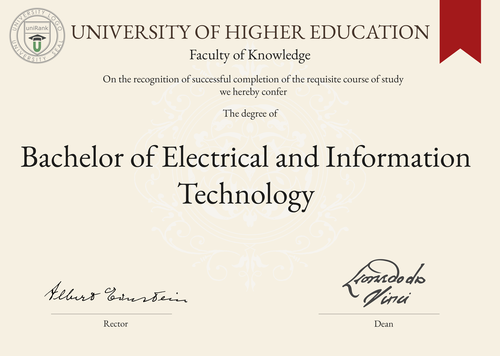
Bachelor of Electrical and Information Technology (B.EIT)
Guide to Bachelor of Electrical and Information Technology Program/Course/Degree
Bachelor of Electrical and Information Technology (B.EIT)

Program Name:
Bachelor of Electrical and Information TechnologyProgram or Degree abbreviation:
B.EITDuration range:
The duration of the program typically ranges from 3 to 4 years.Tuition range:
The tuition fees for the program vary depending on the country and university chosen. It is recommended to check with specific institutions for accurate information.Overview:
The Bachelor of Electrical and Information Technology program provides students with a comprehensive understanding of electrical engineering principles and information technology concepts. It combines theoretical knowledge with practical skills to prepare graduates for a wide range of career opportunities in the field.Curriculum Overview by year:
- Year 1: Introduction to Electrical Engineering, Programming Fundamentals, Mathematics for Engineers, Circuit Analysis. - Year 2: Digital Systems, Signals and Systems, Electromagnetic Fields, Data Structures and Algorithms. - Year 3: Power Systems, Communication Systems, Control Systems, Software Engineering. - Year 4: Advanced Topics in Electrical Engineering, Network Security, Project Management, Industrial Training.Key Components:
The key components of the program include electrical circuit analysis, digital systems design, programming, power systems, communication systems, control systems and software engineering.Career Prospects:
Graduates of the Bachelor of Electrical and Information Technology program can pursue various career paths, including electrical engineer, information technology consultant, systems analyst, telecommunications engineer, software developer and project manager.Salary Expectations:
The salary expectations for graduates of this program can vary depending on factors such as the country, industry and level of experience. It is advisable to research specific job markets for accurate salary information. For a more accurate understanding of salary expectations, you can utilize the Job Sites Search Engine, from our sister site jobRank, which searches over 4,600 job sites worldwide. Make sure to specify not only the job title but also the country you are interested in.Conclusions:
It is important to note that the duration, tuition fees, curriculum, key components, career prospects and salary expectations of the Bachelor of Electrical and Information Technology program can vary based on the chosen country or location for studying the program, as well as the chosen university. Prospective students are encouraged to explore different options and consider their individual preferences and goals. Visitors can search for institutions offering this specific degree, Bachelor of Electrical and Information Technology, anywhere in the world through the uniRank World Universities Search Engine.World Universities Search Engine
search for Bachelor of Electrical and Information Technology (B.EIT) and add the Location (country, state etc.) or specific University you are interested in studying at.
Query examples:
- Bachelor of Electrical and Information Technology (B.EIT) United States
- Bachelor of Electrical and Information Technology (B.EIT) United Kingdom online
- Bachelor of Electrical and Information Technology (B.EIT) Australia international students
- Bachelor of Electrical and Information Technology (B.EIT) University of California
- Bachelor of Electrical and Information Technology (B.EIT) University of London tuition fees
- Bachelor of Electrical and Information Technology (B.EIT) University of Sydney scholarships
Share Program/Course
Interesting? Share this program/course/degree info with your friends now.